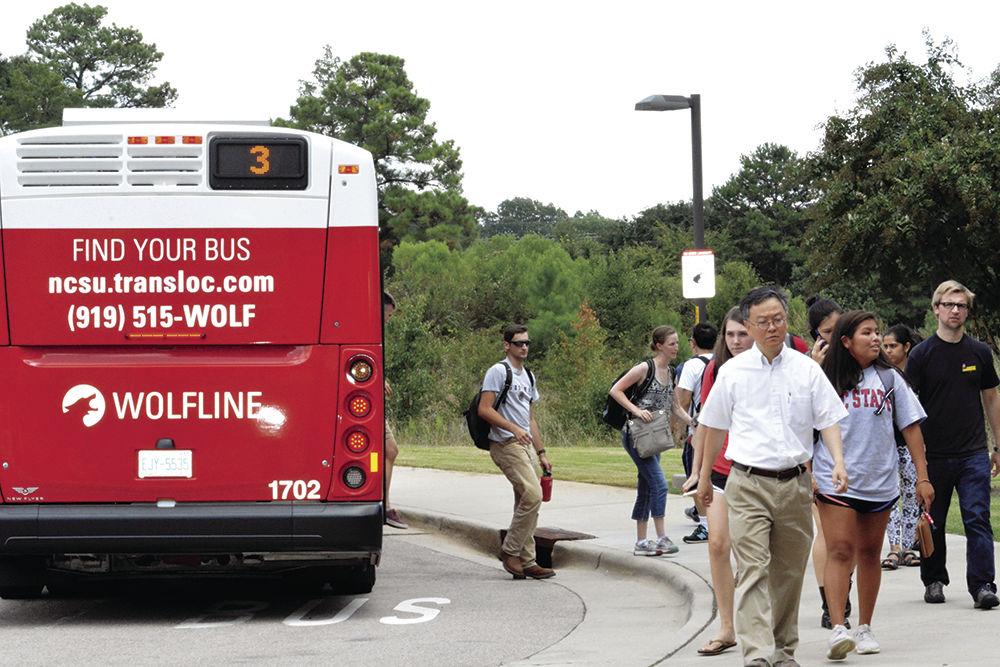The NC State Wolfline bus system has undergone serious renovations for the new academic year. NCSU Transportation has switched contractors, replaced the old buses with 40 newly equipped ones and renovated routes to make the system more efficient for the University.
Students have expressed frustration concerning inconvenient routes or route alternatives, but steps are being taken to address their concerns.
“In particular, major changes were to Route 7 and Route 2, which was discontinued and quasi-replaced by the 7R,” said Byron Bryant, transit manager for NCSU Transportation. “We changed the routing to Route 3 and Route 6. Reasons behind that were efficiency issues, looking at ridership data, where we can shift ridership and maximize our vehicle fleet.”
Additionally, other changes include a new logo and paint scheme designed by College of Design students Ryan Williams and Hunter Williams, and a new bi-directional bus stop at Wolf Village.
“The early reactions have been mixed. Some changes are welcomed, others are not,” Bryant said.
One particularly major route change was to Route 3, which no longer offers transit for students from main campus to the College of Textiles. Route 3 was also a convenient way for Textiles students to access Carmichael Gymnasium.
“I didn’t think that it was going to be cutting off the College of Textiles,” said Kate Puricz, a second-year studying textiles management.
The 8 is the only bus that stops at both the College of Textiles and main campus since the routes have been changed. Puricz says she waited around 20 minutes for the first 8 bus to show up on her first day of classes.
Textiles students who frequent main campus experience similar delays, especially those without certain parking permits. As expected, some students have had to alter their methods of getting to classes, parking lots, Carmichael Gymnasium and other locations.
Rebecca Pierce, a second-year studying textile management, described her process of managing her new schedule in lieu of the route changes.
“I have to walk across Centennial [Campus] to make sure I’m on the right bus to get back to main campus because I still have classes [there],” Pierce said. “I’ve heard a lot of complaints from fellow classmates who always take the buses, and even some people who live off campus but still use the buses, that they’re unhappy with the new bus routes and the timing of them. They seem slower and less efficient.”
Bryant says that the routing and fleet dynamics are reviewed on a semester-by-semester basis and are not a product of the shift to Wolfline’s new bus contractor, Transdev.
“Of course, as you can anticipate, there are going to be bumps in the road,” Bryant said. “As we transition between one company to another, there is a learning process, and a learning curve certainly with that. Hopefully, I can help bridge that gap and smooth out most of those bumps.”
Mitchell Moravec, a fifth-year studying materials science and psychology, created a poll on the Wolfpack Students Facebook group to assess the positive, negative and neutral effects of this situation on students.
“We’ve always consistently, even before my time, had issues with Transportation,” Moravec said. “[They] make a change and need a few months to collect data on it, or see how the new change goes into effect. The problem with that is: ‘we knew these new buses were coming, so as we were collecting data on the latest change, we knew that eventually we were going to change our system anyway.’”
Moravec expressed concern about what he sees as NCSU Transportation’s habit of collecting and interpreting data on changes while aware of impending changes that might render previous ones ineffective.
Moravec also said students found the new 7R Route to be an effective method of returning to parking decks.
Also according to Moravec, Student Body President Jackie Gonzalez has started a “transportation task force” as an alternative method for dealing with student issues with transportation.
The purpose of the task force is to take into account all related concerns, aggregate them all into one entity (in this case, Transportation), and then collect and present data on those concerns with more focus and precision. This way, efforts will appear more unified and problem-solving will be more dispersed.
Ultimately, according to Bryant, NCSU Transportation’s goal is to provide “better, more effective and more efficient service than before.”








